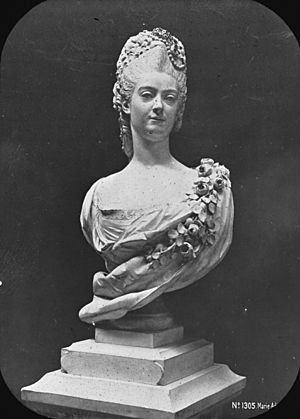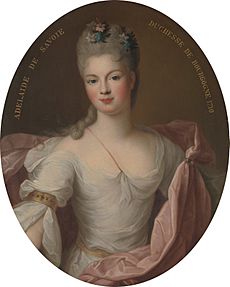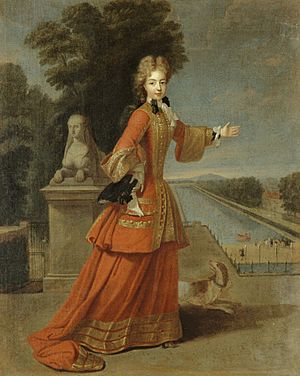Marie Adélaïde of Savoy facts for kids
Quick facts for kids Marie Adélaïde of Savoy |
|||||
|---|---|---|---|---|---|
| Dauphine of France Duchess of Burgundy |
|||||

The Dauphine wearing Fleur-de-lis as Duchess of Burgundy, c. 1697
|
|||||
| Born | 6 December 1685 Royal Palace, Turin, Savoyard state |
||||
| Died | 12 February 1712 (aged 26) Palace of Versailles, France |
||||
| Burial | 23 February 1712 Basilica of St Denis |
||||
| Spouse | |||||
| Issue Detail |
|
||||
|
|||||
| House | Savoy | ||||
| Father | Victor Amadeus II, Duke of Savoy | ||||
| Mother | Anne Marie d'Orléans | ||||
| Religion | Roman Catholicism | ||||
Marie Adélaïde of Savoy (born 6 December 1685 – died 12 February 1712) was a princess who became the wife of Louis, Dauphin of France, Duke of Burgundy. She was the oldest daughter of Victor Amadeus II, Duke of Savoy, and Anne Marie d'Orléans.
Marie Adélaïde was promised to the Duke of Burgundy in June 1696. This was part of a peace agreement called the Treaty of Turin. She later became the mother of the future King Louis XV of France. After her marriage, she was known as the Duchess of Burgundy. When her father-in-law, Le Grand Dauphin, passed away in 1711, she became the Dauphine of France. Sadly, she died from measles in 1712, and her husband passed away just a week later.
Contents
Early Life and Family Background
Marie Adélaïde was born in December 1685 at the Royal Palace of Turin. Her father was Victor Amadeus II, who was the Duke of Savoy. Her mother was Anne Marie d'Orléans, who was a niece of the powerful French king, Louis XIV.
When Marie Adélaïde was born, her mother, who was only sixteen, almost died. Because of a rule called salic law, girls could not inherit the Duchy of Savoy. So, Marie Adélaïde could not become the ruler.
She had a very close bond with her grandmother, Marie Jeanne of Savoy, and her mother. It was unusual for royal mothers at that time to raise their own children, but Marie Adélaïde's mother did. As children, Marie Adélaïde and her sister Maria Luisa often visited their grandmother.
Marie Adélaïde was quite small, sometimes described as "doll-sized." She had chestnut hair when she was young, which became darker as she grew up. She also had large, dark eyes with long eyelashes.
Betrothal and Royal Marriage
Marie Adélaïde's marriage was arranged because of the Treaty of Turin. This treaty was signed on 29 August 1696 between her father and King Louis XIV of France. It meant that her father would support France in a war called the Nine Years' War. Her father's lands had been badly damaged during this war.
Before this, her father had suggested Marie Adélaïde marry Archduke Joseph. But the Emperor said no because they were both too young. As part of the Treaty of Turin, it was suggested that Marie Adélaïde go to France early. This was so she could learn how to act at the French court before marrying the French prince.
When she arrived in France, King Louis XIV met her on 4 November 1696. He was very happy with the young princess. Since she was only 11, the wedding did not happen right away. Instead, she spent three days a week studying at the Maison royale de Saint-Louis. This was a special school for girls founded by Madame de Maintenon near Versailles.
On 6 December 1697, her twelfth birthday, Marie Adélaïde officially married the Duke of Burgundy. The wedding took place at the Palace of Versailles. This happened after the Treaty of Ryswick was signed, which ended the Nine Years' War. Her husband was the oldest son of Le Grand Dauphin.
Life as Duchess of Burgundy
As the new Duchess of Burgundy, Marie Adélaïde became very close to King Louis XIV and Madame de Maintenon. People at Versailles said her arrival was like "a breath of fresh air." She made the court more lively and fun. She also wrote letters often to her parents and grandmother in Savoy.
Many people at court, like Louis de Rouvroy, described her as a very spirited and energetic woman. She was known for her charm and influence.
The Duchess of Burgundy had three children. Her first son, born in 1704, was called the Duke of Brittany, but he sadly passed away in 1705. She had two more sons in 1707 and 1710. Her youngest son was the only one to live past childhood. He later became King Louis XV of France.
Becoming Dauphine of France
In April 1711, her father-in-law, Le Grand Dauphin, became sick with smallpox and died. After his death, Marie Adélaïde's husband became the new Dauphin of France. This meant Marie Adélaïde became the Dauphine of France.
In February 1712, the royal court traveled to Fontainebleau. There, Marie Adélaïde caught a fever that turned out to be measles. Despite efforts to treat her, she died at Versailles at the age of 26. King Louis XIV and Madame de Maintenon were very sad. It was said that Marie Adélaïde was one of only two people King Louis XIV truly loved in his life.
After her death, the royal family moved to Marly to stop the illness from spreading. Sadly, Marie Adélaïde's husband, the Dauphin, also caught measles from her. He died six days later at Marly.
Marie Adélaïde and her husband were buried together at the Basilica of Saint-Denis on 23 February 1712. Their son, the Duke of Brittany, became the new Dauphin. But he also died from measles the next month.
The only child to survive the epidemic was the future Louis XV. He was kept safe in his rooms with his governess, Madame de Ventadour. She was famous for saving his life by preventing doctors from using dangerous treatments. Later, King Louis XV named his fourth daughter Marie Adélaïde in honor of his mother.
A famous statue of Marie Adélaïde was made by Antoine Coysevox in 1710. In the statue, she is shown as the Roman goddess Diana. This statue is now in the Louvre museum.
Children
- Louis of France, Duke of Brittany (born 25 June 1704 – died 13 April 1705). He passed away from convulsions.
- Louis of France, Duke of Brittany (born 8 January 1707 – died 8 March 1712). He died from measles.
- Louis of France, Duke of Anjou, who later became King Louis XV (born 15 February 1710 – died 10 May 1774). He married Marie Leszczyńska and had children. He died from smallpox.
In Fiction
- Today Dauphine Tomorrow Nothing, a novel by Saga Hillbom (2019).
See also
 In Spanish: María Adelaida de Saboya para niños
In Spanish: María Adelaida de Saboya para niños





